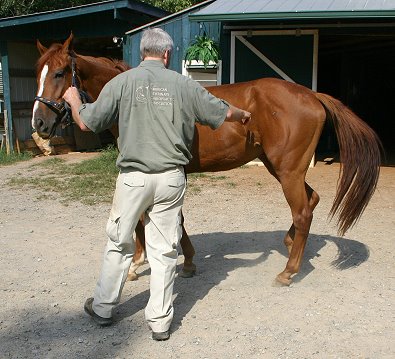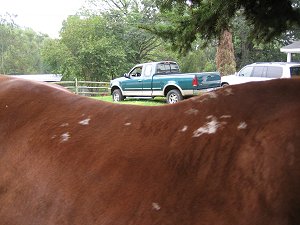While giving credit where it is due, I also have to mention he is the one who taught me how to check their back for soreness. Not one of the farms I have worked at over the years, Not one of the 'big name' or so called 'trainers' in any discipline, ever did it themselves or bothered to show me or the other grooms how... Nope! I learned it from him. I have also learned a lot of other things, but this is one of the simplest and most important things, as a rider, when it comes down to the horses comfort.
In looking for pictures (so I don't have to take my own and make everyone wait for that too!) I found this series-

Thank you Equisearch! Yes the link is to the article which also has a bit more information as far as checking your saddle fit too. I highly recommend the read and consider the information with an open mind. Their website has a lot of articles and helpful information for all levels of experienced horse people.
The one minor difference in how we check our horses backs is that we start up near the withers with a finger on one side and thumb on the other side of the spine- right about where either side of the saddles' gullet area would lay. We gently push down on the back as we slide our finger and thumb from the withers back to the hip while watching for any twitching, flinching or reaction from the horse. We apply gentle pressure at first, then a little more the second time. If there is a sore spot- your horse will feel it and you will see their response. Then as the article states we move the 'line' down to where the thumb has made a line as pictured above.
Check from both sides as you may not see a response on the right while standing on the left. Check before and after each ride. Checking before the ride can be done while you are brushing them off. Checking after, just after you have pulled the saddle and are looking for dry spots under the pad anyways. Checking after the ride is a good time to do so, as the muscles will be warm from work, but also because if there is any soreness from the pressure of the saddle and a riders weight- your horse will certainly react. It will be 'fresh' soreness, not something that has become just a dull ache, which they may have developed a tolerance of.
If minor soreness is found before a ride, I recommend doing the stretches previously discussed and then groundwork for the day. Lunge the horse, letting them warm up the muscles, relax and going around at an easy pace. Afterwards, do a few more stretches and check for soreness again. If it is minor, then perhaps the horse just needs a little extra work that is focused on stretching and relaxing that area. Maybe they just slept on the wrong side of the stall? Give them a few days of this and keep checking for an improvement.
I do not recommend saddling them during this time, simply because if the saddle is causing the pain then it may just keep putting pressure on that area and likely no improvement will be made. If the issue 'resolves itself' through this process, then start just by saddling the horse and lunging them a few days, continuing to do the stretches and checking before and after their workout. If the soreness does not reoccur, then proceed to move on to riding again- still stretching and checking before and after rides.
The minor soreness may have been a one time deal or may be caused by the saddle, but without a riders weight- not enough weight to apply pressure to that spot. If the soreness comes back, then checking your saddle and pad are certainly one place to start as well as having your horse evaluated for chiropractic care. A massage would also be something to consider as well as having their hoof care and shoeing re-evaluated for proper balance. Finding the true cause of the pain can take some effort, but once it is found and resolved, your horse will certainly be grateful.












